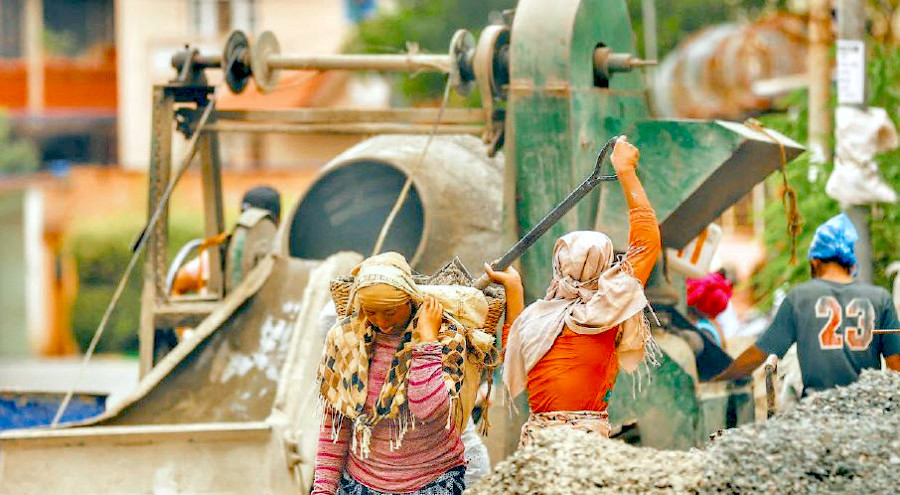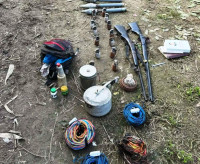National
Experts paint a bleak picture of the economy as the pandemic hits harder
Prompted by a rising virus caseload, authorities are tightening restrictions which could result in a massive economic contraction.
Prithvi Man Shrestha
In normal times, the country's commercial banks would be busy issuing loans right and left at the start of every new fiscal year. In mid-July, lenders would be bracing for a hectic season.
“That is the time importers seek loans for importing goods targeting the Dashain and Tihar festivals,” said Gunakar Bhatta, spokesperson for Nepal Rastra Bank. “But the report I have received shows that banks have been hardly issuing loans since the fiscal year started.”
When the current fiscal year started on July 16, the entire country was in the fourth month of the lockdown that the government had imposed from March 24 to contain the spread of the coronavirus.
Businesses and factories were shuttered, shops were closed, tourist arrivals were down to zero, and restaurants and hotels teetered on the edge.
According to the Nepal Bankers’ Association, there has been a substantial drop in new lending by commercial banks.
The association's data shows outstanding lending of commercial banks decreased to Rs2.88 trillion as of August 21 from Rs2.9 trillion at the end of the last fiscal year 2019-20, down around Rs17 billion.
“This suggests that there has been greater recovery of existing loans than new loans,” said Bhuvan Dahal, chief executive officer of Sanima Bank.
The government on July 21 decided to lift the lockdown.
As the country saw a massive spike in the Covid-19 caseload, local administrators imposed prohibitory orders in various districts, shutting down businesses and factories again. Kathmandu, Lalitpur and Bhaktapur, the three districts in the Kathmandu Valley, too were put under prohibitory orders effective August 19 midnight, shattering hopes of an economic recovery.
“Due to the ongoing restrictions, the contribution to the economy from the consumption of goods and services is set to decrease substantially,” said Bhatta. “If the current situation continues until the festival season, when consumption skyrockets, the economy will get hit even harder.”
Consumption in the last fiscal year was 82 percent of the gross domestic product. A significant portion of consumption that takes place during the festival season will be wiped out from the economy due to the ongoing restrictions.
The Covid-19 pandemic has hit the economies of almost every country across the world. Neighbouring India said earlier this week that its economy saw a sharp contraction of 24 percent in the three months till June-end–the worst slump since the country started releasing quarterly data in 1996.
India’s slump was the worst among the world’s major economies, with the United States’ economy contracting by 9.5 percent in the same quarter and Japan’s by 7.6 percent.
The decline in India is largely attributed to the months-long lockdown, one of the severest in the world, that was enforced almost simultaneously with Nepal. Construction, manufacturing and transport industries were among the hardest hit.
The sectors that were hit the hardest in India have taken a beating here in Nepal as well.
Finance Minister Yuba Raj Khatiwada, who presented the budget for the current fiscal year on May 28 amid the looming virus threat, however, has set an ambitious growth target of 7 percent, which economists now say is almost impossible to achieve.
“The country’s estimated growth for the last fiscal year is 2.27 percent, when the economy was running smoothly during the first eight months,” said economist Keshav Acharya. “The new fiscal year began amid a suspension of almost all economic activities due to the virus. This suggests that the economic situation will be bleaker this year.”
Amid the rising number of infections, the authorities are now mulling even stricter restriction measures, which could ground all the industries to a complete halt. During the four-month lockdown, around 61 percent of the factories were shut down completely, according to a central bank study.
With the government failing to come up with a clear plan for industries, businesses and service sectors, businesspersons are worried.
Satish Kumar More, president of the Confederation of Nepalese Industries, said most factories except those producing essential goods remained closed due to the prohibitory orders issued by the local administrations.
“There is an environment of fear created by a lack of proper planning and recovery measures by the authorities,” said More. “The government is more focused on shutting down everything instead of facilitating industries which can at least operate following health and safety protocols.
According to the World Bank, should cases in Nepal continue to rise and should a rebound in economic activity in the country’s major trading partners and remittance-sending countries be delayed, growth in fiscal 2020-21 risks turning negative, with a contraction of 2.8 percent possible.
“An economic contraction would risk exacerbating poverty, inequality and food insecurity because of a large informal economy,” said the World Bank. An estimated 31.2 percent of the Nepali population who live close to the poverty line (between $1.90 and $3.20 a day) are at high risk of falling into extreme poverty.
And economists say they foresee the country heading towards a massive economic contraction.
“What is concerning is we are losing from almost every sector. Almost all segments are expected to see a negative growth,” said Acharya. “Wholesale and retail, ground and air transport, tourism, hotels, finance and construction and industrial sectors all have been badly affected.”
A couple of sectors that the country was looking up to were construction and agriculture amid dismal growth.
The country this year saw a good paddy transplantation, but economists say the government’s failure to make available fertiliser on time could affect the desired output.
This fiscal year, the country completed its paddy transplantation on 98 percent of the available 1.37 million hectares, the highest transplantation rate recorded in the last five years, according to the Ministry of Agriculture and Livestock Development.
But the government failed to ensure an adequate supply of fertilisers during the transplantation season.
Bhatta of the central bank said there is still hope from the construction sector if the government creates a conducive environment for construction projects to move ahead immediately after the upcoming festivals.
Construction activities in Nepal usually pick up pace after the Dashain and Tihar festivals every year. The sector contributes a little over 7 percent to the economy, according to the Central Bureau of Statistics.
Experts, however, say it all depends on whether the country can manage to slow the spread of the virus.
Shankar Sharma, former vice-chair of the National Planning Commission, said the way the world is struggling and Nepal, too, is failing to contain the spread of the virus, there is no hope for at least the first three quarters of the current fiscal year.
“Even if we reopen the economy fully in the last quarter if the virus slows or a vaccine becomes available, we will see meagre growth,” Sharma told the Post.
According to a recent survey report by Nepal Rastra Bank, businesses will take an average of nine months to return to normalcy after restrictions are lifted.
Acharya said that it would take the entire fiscal year for businesses to get back to pre-lockdown conditions.
“Even if the situation normalises now, it will take an entire year for business activities to return to normalcy, which will mean the economy will be hit hard,” said Acharya.
The situation, however, deteriorated further after the stay-home order was lifted. Prohibitory orders were issued which have been extended by a week in the Kathmandu Valley. This discouraged businesses from seeking new loans from banks and financial institutions.
The slump in demand for credit is one of the reasons why there is excess liquidity totalling over Rs200 billion, according to the central bank.
Economists and bankers say a situation where financial institutions have enough money but borrowers are shy is not a good sign for the economy.
Credit expansion is one of the key indicators of how the economy is performing.
“Usually, during this time of the fiscal year, banks start to issue loans,” said Dahal, who is also the president of the Nepal Bankers’ Association. “Demand for loans compared to the same period in the last fiscal year is much lower.”
According to the Nepal Bankers’ Association, outstanding loans increased by around Rs9 billion in the first month of the last fiscal year compared to the end of the previous fiscal year. But outstanding loans decreased by around Rs25 billion in the first month of the current fiscal compared to the end of the last fiscal year.
As reduced economic activities resulted in low loan demand, the government has continued to bar economic activities, even sectors that pose little risk.
“The government even stopped online sales of food items where there is minimum risk,” said Acharya. “The whole emerging scenario shows that the country is heading towards an economic contraction in the current fiscal year."




 9.12°C Kathmandu
9.12°C Kathmandu
%20(1).jpg&w=200&height=120)














